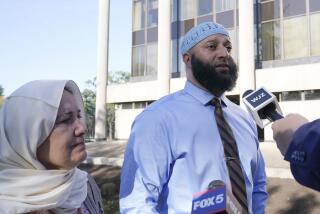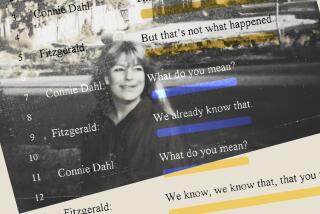The book ‘Adnan’s Story’ and what it tells us about ‘Serial’
- Share via
Rabia Chaudry is a woman on a mission.
She’s the one who approached “This American Life” producer Sarah Koenig about Adnan Syed, who was sentenced to life in prison for a murder he says he didn’t commit. That story turned into “Serial,” the podcast mega-hit that debuted in 2014. The first season, which took an intense look at Syed’s case, has been downloaded more than 80 million times.
Chaudry is a longtime friend of the Syed family who is convinced of Adnan’s innocence. After “Serial” ended, Rabia Chaudry co-hosted her own podcast, “Undisclosed.” Now we have her new book, “Adnan’s Story: The Search for Truth and Justice After ‘Serial.’”
The first half of the book focuses on the details of the investigation and court proceedings. It is rather dense and at times reads like an attorney case file — not surprising because Chaudry is a lawyer.
Syed was accused of killing his ex-girlfriend, Hae Min Lee, but Chaudry’s basic assumption is that someone else must have. Her book is critical of every move made by the police and court system. Even the man who found Lee’s body isn’t safe from scrutiny: She makes note of his arrest record for indecent exposure and includes crimes committed more than a decade after the murder took place.
Syed’s case has been back in the news: In June he was granted a new trial based on questions about cellphone-tower evidence, and in July the state of Maryland announced that it intends to fight that ruling.
As “Serial” listeners will remember, cellphone-tower pings were what confirmed the state’s timeline of the day Lee was murdered. Publisher St. Martin’s Press says the book will include a letter from the author with her reaction to the news of Syed’s conviction being vacated (but the story may be moving too fast for them to keep up).
The cell tower records are addressed at length in the book, along with more information “Serial” listeners never learned. A few of the major surprises:
1) Syed was almost exonerated after his first trial. The first trial ended in a mistrial because of a lawyer’s mistake. Members of that first jury later said they would most likely have found him not guilty.
2) The investigating detectives had a habit of going after the wrong guy. Chaudry goes over three other cases involving the same police detectives that ended with innocent men being incarcerated and later exonerated. The cases shared a number of similarities to Syed’s.
3) Islamophobia played a big part in the state’s case. A large portion of the book focuses on the role Syed’s religion played in his life and in the investigation. Chaudry contends that the police and the state attorney’s office relied on a number of untrue and ugly stereotypes about Islam to make their case against Syed, some of which were unfortunately repeated in “Serial.”
‘Serial’ had taken what seemed like a routine state-level homicide case and made it something mythical, magical.
— Rabia Chaudry
4) “Serial” wasn’t the story Chaudry wanted to tell. Part of what made the podcast so enthralling was how it explored Syed’s case from the side of someone who wasn’t sure if he did it or not. Even by the last episode, Koenig confessed she couldn’t conclusively assert his innocence. While that was exciting for listeners, who tuned in every week to find out more twists and turns, this was incredibly painful for Chaudry (and Syed’s family, and Syed himself) to listen to. She had hoped “Serial” would tell Syed’s story as one of an innocent man wronged, as opposed to putting him on trial all over again. It led to a number of heated exchanges between Koenig and Chaudry, including at least one shouting match.
The detailed, documentary nature of “Serial” made it seem like listeners were hearing all the facts; in bringing up these fights that never made it into the podcast, Chaudry’s book shows us how the producers were also shaping the story.
5) Jay Wilds had at least one possible motive. “Serial” listeners noted Wilds was the only person ever directly connected to Lee’s murder. He came to the police and showed them where her missing car had been stashed and was the state’s star witness in implicating Syed. Podcast listeners argued back and forth online that, despite all that, Wilds lacked a motive to kill Lee. According to “Adnan’s Story,” there was one: Wilds was cheating on his girlfriend, and Lee knew about it and had threatened to tell her.
6) But Wilds may have not been connected to the case at all. Toward the end of the book, Chaudry uncovers evidence suggesting Wilds was heavily pressured by the police into testifying against Syed and that everything he said — including the location of Lee’s car — was invented by investigators to prop up their case.
It was easy to forget, listening to “Serial,” that it was a true story about real people. “Adnan’s Story” adds context and humanizes it in a way that could change how you think about the case, and about “Serial” itself.
::
“Adnan’s Story: The Search for Truth and Justice after ‘Serial’”
By Rabia Chaudry
St. Martin’s Press: 416 pp., $26.99
More to Read
Sign up for our Book Club newsletter
Get the latest news, events and more from the Los Angeles Times Book Club, and help us get L.A. reading and talking.
You may occasionally receive promotional content from the Los Angeles Times.







